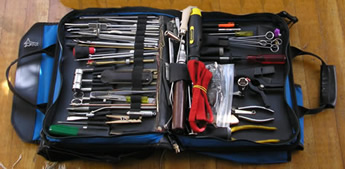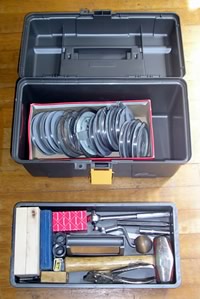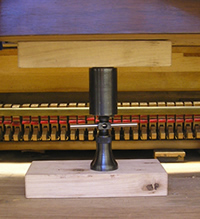Training … Experience … and the Right Tool for the Right Job
It is important to distinguish between a piano tuner and a piano technician. There are some people who have learned to tune pianos (well or not – see the page on Tuning), but have never been trained to work on the mechanical parts of the piano. Although it is possible to learn to fix a machine by trial and error, this means that someone’s piano (possibly yours) is being experimented on. The piano mechanism is complicated enough that a sloppy or improper repair can cause other problems which did not originally exist.

Special tools for working on pianos
We were trained how to diagnose and perform all the common repairs before we ever started tuning pianos for the public. We worked on pianos and old left-over parts which we practiced on, and we ruined a lot of those “throw away” parts while learning. But those parts were not going into anyone’s piano, and certainly no one was getting charged for out “learning experience.”
After being trained, Scott and I both passed the rigorous, standardized tuning and technical examinations offered by the Piano Technicians Guild. During the technical exam, which is entirely hands-on, we had to demonstrate that we could perform common repairs properly within the time limits of the test.
Along with experience, we bring an extensive set of tools, most of which are designed especially for work on piano parts. We bring several types of glues and lubricants. We bring many spare parts and can order any special parts which we don’t carry with us. We also bring piano wire in a variety of gauges, and tools which allow us to repair or replace strings.
Broken or Sticking Key
The most common repair call I get is for a “broken key.” Usually, the customer means that when the key is pressed down, the note doesn’t
play. Or they may mean that the key is depressed and won’t come back up. In either case, my response is the same. There are at least a dozen different reasons why a note won’t play. Some of these may take me only a few seconds to fix, and some may take me half an hour or more. Most often, they are quick fixes – something is stuck, or something is broken but easily fixed. In that case, I do not charge anything if I am already tuning the piano. If it takes more than a few minutes to fix, we will charge by the hour.
In a newer piano, the most common cause of a sticking key is a felt bushing binding against the front rail pin (a pin that pokes up from the keybed into the bottom of the key). This is more likely to occur in humid weather, since the humidity causes the felt to swell up. I have a special tool which squeezes and compresses the felt. No more sticking key!
Sometimes the hammers are too close together and rub against each other, causing one note not to play. This is also easily adjusted in most pianos.
In older upright pianos, there are several likely causes of what appears to be a sticking key – none of which have to do with the key actually sticking. The jack flanges often come unglued. The key itself can crack at the balance rail hole. (This really is a “broken key.”) The hammer shank can break. These repairs take more time. But I have experience in repairing them all, and many, many more.
And, of course, there are animal-induced and human-induced sticking keys we have encountered: mouse turds or loose change stuck between the keys. Pencils, toys, and other objects which have fallen into the piano and are lying on top of the backs of the keys.
Broken string
Strings almost never break on newer or recently restrung pianos because new piano wire is extremely elastic.

Piano wire in various gauges and special tools for replacing strings
On older pianos, if the strings have become brittle with age, they are more likely to break – even if the change is tension is very slight. However, I have very rarely had a string break while tuning a piano, even when doing an extreme pitch raise. Of course, because of my training, I am able to replace or repair a broken string whether it happened “on my watch” or not. (The photo at left is my toolbox for string repair, and includes spools of wire in various gauges.)
In the case of a broken bass string, which is a “wound string” (core wire with other wire wrapped around it), if the broken string is still available, it is often best to splice the old string back into place if possible. If a bass string is missing, a new one can be ordered. However, each bass string on each make and model of piano is different. Ideally, the broken string is available to send in to be duplicated. If it is not available, I take measurements to send to the duplicating service.
If more than a few strings are broken in a piano upon my arrival, it is usually an indication that the strings are extremely brittle. This is the only time I would avoid a pitch raise. If the situation is really extreme, the only solution may be to restring the piano, an expensive proposition, and usually not worth it on vertical pianos.
Chipped or missing keytops
White keytops are made of either ivory or plastic.
Ivory keytops
Each ivory keytop is actually two pieces of ivory, butted together: the wider part (the part which is played on) and the narrow part or “tail” that extends back between the black keys. Pianos from the early 1900s originally had ivory keytops, altho many pianos from that era have had the ivory replaced with plastic keytops.
Chipped ivories
If a few keys have chipped ivory, I can often repair the chips with a special mixture called “AcryliKey” developed by Richard Wagner, a piano
technician from Portland. There are many varieties of ivory keytops out there. Most are good candidates for having chips repaired, some are not. I can only tell when I see the keys.
When a lot of keytops are chipped, it is more cost effective to have all the white keytops replaced with plastic tops. See below.
Missing ivories
Sometimes the original glue holding the ivories on dries out too much and the keytops pop off. The best case scenario is that the owner has the keytops or they are still inside the piano somewhere (under the keys, for instance). In that case, we can clean them and glue them back on properly.
Ivories have been improperly glued on if they “look really different” from the keys that are still originally attached. Usually these improperly glued keytops will look darker, streaky, or otherwise ugly. This is because ivory is translucent. If the back of an ivory keytop is not coated with something white, the wood of the key (and possibly dirt and old glue, if the keytop has been off for a while) will show through the ivory. If the keytop was not glued on with something permanent, like super glue, it can be removed, cleaned and reglued properly.
When the ivory tops are really missing and not available, we can try to match them as well as we can using keytops we’ve removed from keys that were sent for recovering. Because of the wide variety of types of ivory, if keytops are replaced like this by us or some other technician, they may not match perfectly.
If more than a few keytops are missing, it is usually more cost efficient and attractive to have all the white keytops replaced with plastic. See below.
Plastic keytops
If there is no “join” between the front and “tail” part of the white keytop, it is plastic. (Some ivory keytops are so well joined and buffed that it is hard to see the join. You may have to look really hard.) If a plastic keytop is missing or damaged, it can be replaced. However, there are a few thicknesses of plastic tops, and some plastic keytops have the fronts attached. We may have a plastic keytop with us that matches your piano’s, we may have to order them, or they may not be available at all in which case your only option would be to replace all the white keytops.
Replacing a whole set of keytops
If your piano needs all the keytops replaced (either all the white keys, or both white and black keys), we send them to a technician in the Portland area who specializes in this repair – in fact, it is all he does! This ensures that our customers get a high quality job, performed by someone who has a shop set up with the specific equipment needed to do a perfect job and offer a fast turn around. We will pick up your keys, pack them, ship them, bring them back and replace them in your piano. This process does not affect any other aspect of your piano, like tuning or regulation.
Black keytops
Black keys in older pianos and some new pianos are wood, usually ebony, that is stained black. Beginning sometime in the mid-1900s, manufacturers started making black keytops out of plastic. There are a few sizes of black plastic keytops. We carry some with us and can order others if a black keytop has come off and is lost.
Black wood keytops which have the finish worn off and the wood grain showing can be lightly sanded and dyed.
Cracked soundboard
The soundboard is a thin piece of wood that spans the entire back of the piano. It acts as an amplifier. Although many people believe that if the soundboard is cracked, the piano is “no good,” a cracked soundboard usually has no effect on the sound of the piano. In cases where the crack has caused the soundboard to become loose from the ribs on the back of the piano, causing a buzzing noise, a repair can almost always be done to screw and glue it back against the ribs.
Cracked Pinblock/Loose Tuning Pins
The pinblock is a laminated piece of wood several inches thick that is secured behind the plate. The finely threaded tuning pins are pounded through holes in the plate into holes in the pinblock. There are two common reasons why tuning pins become loose.
“Worn out” pinblock
Most commonly, the pins have become loose from decades of having them turned back and forth in the holes during tuning, much like a wood screw that has stripped its hole.

Pinblock jack for use when replacing strings in grand pianos
In this case, the pins can often be pounded a little further into the pinblock, which will give the piano many more years of life before anything more needs to be done. In grand pianos, before pounding the pins in, the action must be removed and a special pinblock jack must be set up to support the pinblock to prevent the laminations in the pinblock from splitting.
If the pins are already in as far as they should go, the piano can be restrung with over-sized pins and the piano will usually have another 40 or so years of life. An old treatment that was popular at one time was to apply a glycerin solution to the pinblock which would swell the wood up and sometimes get the pins to hold for a while. However, this makes the wood mushy and might make it impossible to use over-sized pins in the future. More recently, technicians have experimented with applying various types of glues to the pinblock with good results, however I do not have experience with this technique. Only in the case of a piano that is completely untunable and is going to be either thrown out or completely rebuilt at a later date would I risk “doping” the pinblock.
Cracked pinblock
A more serious problem is when there is a crack in the pinblock between two or more tuning pins. The crack causes the holes to open up and the pins to become so loose they will not stay in place when tension is placed on them. Cracks in the pinblock can be caused by a poor quality pinblock, excessively dry environment causing the wood to dry out, and – in a grand piano – by an inexperienced technician pounding the pins in without supporting the pinblock from underneath with a jack, causing the laminations to split apart.
If a vertical piano has a cracked pinblock, it is often not worth the cost of fixing it. In a grand, the usual solution is to replace the pinblock, although this is quite expensive and would only be considered in a quality piano.
Some technicians have had success with removing all the strings and tuning pins, filling the holes with epoxy, and then drilling them out again.